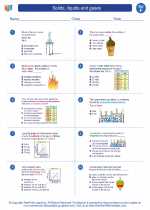Solids, liquids and gases -> melting point
Melting Point
The melting point of a substance is the temperature at which it changes from a solid to a liquid state. It is an important physical property of a substance and can be used to help identify and characterize different materials.
Factors Affecting Melting Point
The melting point of a substance is influenced by several factors:
- Intermolecular Forces: Substances with stronger intermolecular forces generally have higher melting points. For example, ionic compounds typically have high melting points due to the strong attraction between positive and negative ions, while nonpolar molecules have lower melting points due to weaker van der Waals forces.
- Molecular Structure: The arrangement and shape of molecules can also affect the melting point. Substances with symmetrical and closely packed molecules tend to have higher melting points.
- Impurities: Adding impurities to a substance can lower its melting point. This is known as melting point depression and is commonly used in the process of freezing point depression to lower the freezing point of water in antifreeze solutions.
Measuring Melting Point
The melting point of a substance can be determined using a variety of techniques, including:
- Melting Point Apparatus: A device that heats a sample at a controlled rate and measures the temperature at which it begins to melt.
- Capillary Tube Method: A small amount of the sample is placed in a capillary tube, which is then heated while observing the temperature at which the substance changes state.
- Differential Scanning Calorimetry (DSC): A technique that measures the heat flow into or out of a sample as it is heated or cooled, providing information about changes in state such as melting.
Importance of Melting Point
The melting point is an important property for several reasons:
- Identification: It can be used to help identify unknown substances by comparing their melting points to known values.
- Purity: The melting point of a pure substance is a characteristic value, so deviations from the expected melting point can indicate impurities in the sample.
- Industrial Applications: Knowledge of melting points is important in industries such as materials science, pharmaceuticals, and manufacturing, where precise control of melting and solidification processes is critical.
Study Guide
When studying the concept of melting point, consider the following key points:
- Understand the definition of melting point and its significance in identifying and characterizing substances.
- Learn about the factors that influence the melting point of a substance, including intermolecular forces, molecular structure, and impurities.
- Be familiar with the methods used to measure melting points, such as the melting point apparatus, capillary tube method, and differential scanning calorimetry.
- Recognize the importance of melting point in various applications, including its role in substance identification, purity determination, and industrial processes.
By mastering the concept of melting point and understanding its practical implications, you can gain a deeper understanding of the behavior of different materials and their applications in various fields.
[Melting Point] Related Worksheets and Study Guides:
.◂Science Worksheets and Study Guides Sixth Grade. Solids, liquids and gases

 Activity Lesson
Activity Lesson
 Worksheet/Answer key
Worksheet/Answer key
 Worksheet/Answer key
Worksheet/Answer key
 Worksheet/Answer key
Worksheet/Answer key
 Vocabulary/Answer key
Vocabulary/Answer key
 Vocabulary/Answer key
Vocabulary/Answer key
